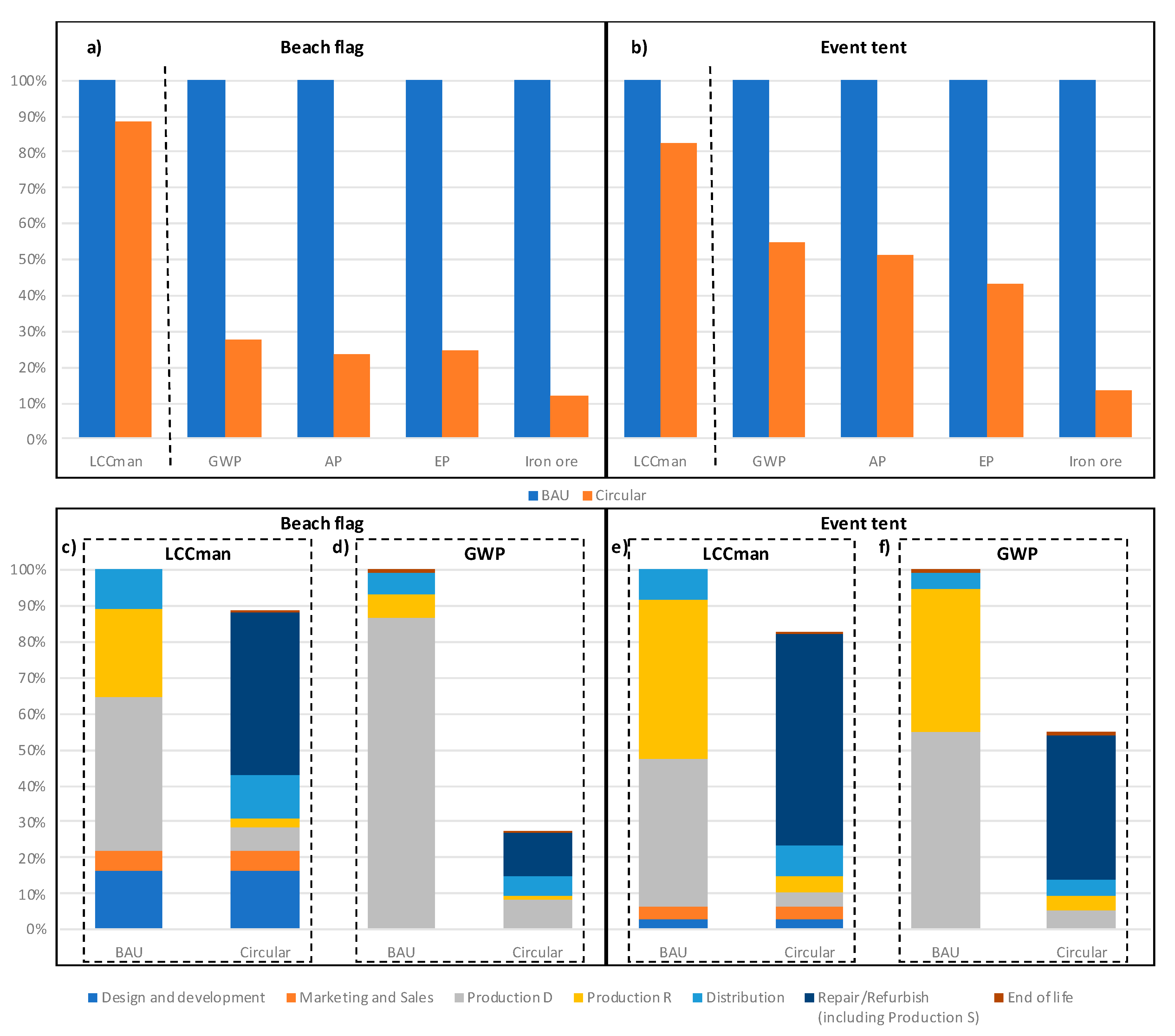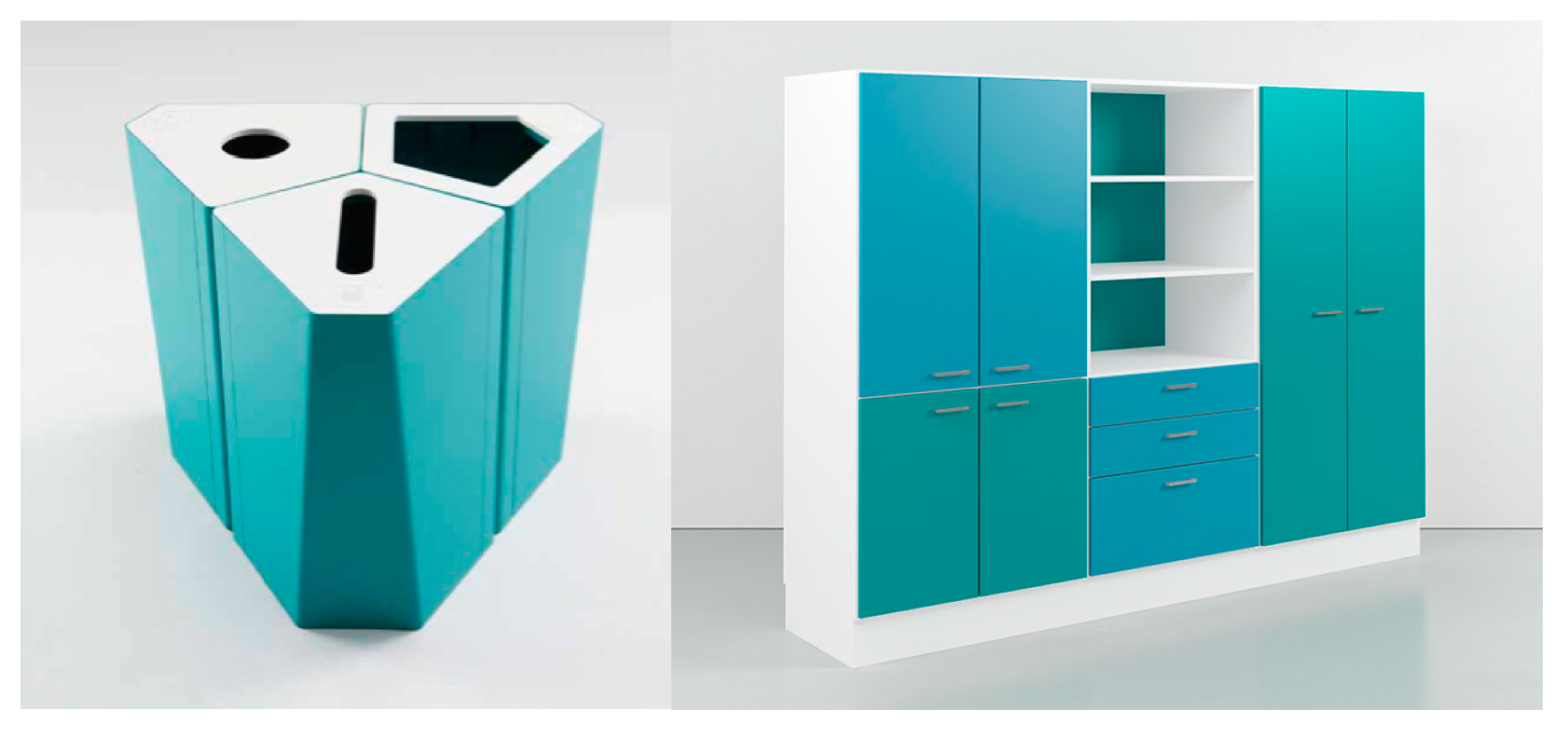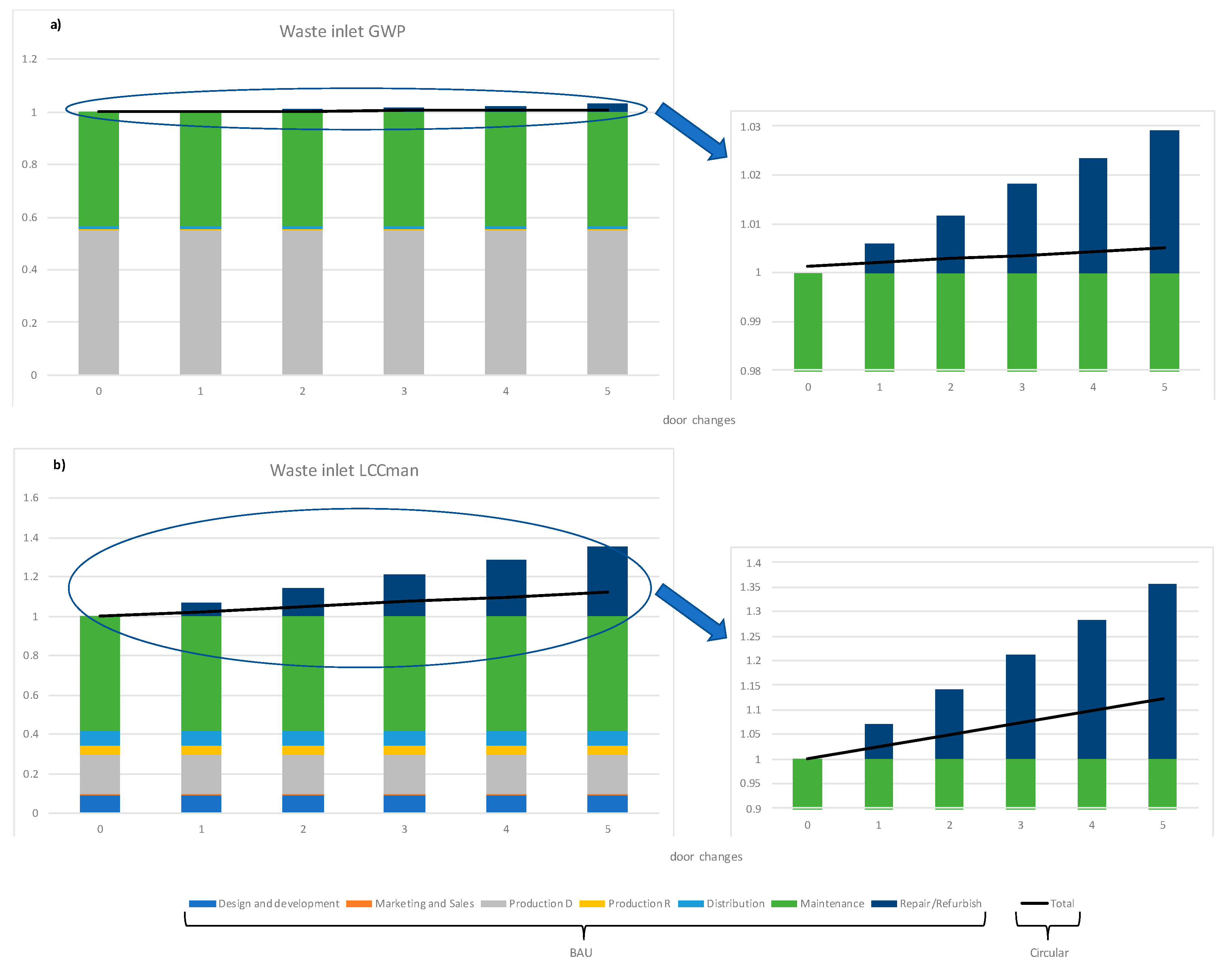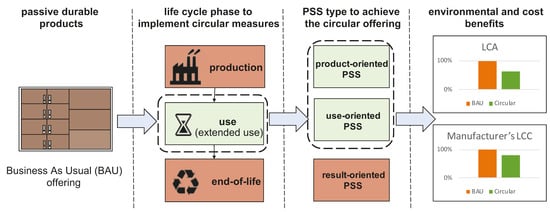Is Prolonging the Lifetime of Passive Durable Products a Low-Hanging Fruit of a Circular Economy? A Multiple Case Study
Abstract
:1. Introduction
- documenting cases where the lifetime of durable passive products has been prolonged through the addition of services;
- quantitatively assessing the implications of the measures from an environmental perspective using life cycle assessment (LCA), and from a cost perspective using life cycle costing (LCC), and;
- discussing the potential of prolonging the lifetime of passive durable products to contribute to a more circular economy while being economically viable for the manufacturer.
2. Background and Motivation
3. Materials and Methods
3.1. Overview
3.2. LCC and LCA
4. Case Studies
4.1. Refurbishment of Beach Flag and Event Tent
4.1.1. Case Product and Company
4.1.2. Results
4.1.3. Sensitivity Analysis
4.2. Repair of Recycle Bin and Locker
4.2.1. Case PRODUCT and Company
4.2.2. Results
4.2.3. Sensitivity Analysis
4.3. Repair of Waste Inlet
4.3.1. Case Product and Company
4.3.2. Results
4.3.3. Sensitivity Analysis
5. Discussion
5.1. Discussion of LCA Results
5.2. Discussion of LCCman Results
5.3. Limitations of LCC and Discussion of Rebound Effects
6. Conclusions
Supplementary Materials
Author Contributions
Funding
Acknowledgments
Conflicts of Interest
References
- UNEP. Decoupling Natural Resource Use and Environmental Impacts from Economic Growth, A Report of the Working Group on Decoupling to the International Resource Panel; Fischer-Kowalski, M., Swilling, M., von Weizsäcker, E.U., Ren, Y., Moriguchi, Y., Crane, W., Krausmann, F., Eisenmenger, N., Giljum, S., Hennicke, P., et al., Eds.; UNEP: Nairobi, Kenya, 2011. [Google Scholar]
- EC. Closing the Loop-an EU Action Plan for the Circular Economy; COM(2015) 614 Final; European Commission: Brussels, Belgium, 2015; Available online: https://www.eea.europa.eu/policy-documents/com-2015-0614-final (accessed on 15 October 2018).
- EMF. Towards the Circular Economy, Economic and Business Rationale for an Accelerated Transition; Ellen MacArthur Foundation: Cowes, UK, 2013; Volume 1. [Google Scholar]
- Bocken, N.M.; de Pauw, I.; Bakker, C.; van der Grinten, B. Product design and business model strategies for a circular economy. J. Ind. Prod. Eng. 2016, 33, 308–320. [Google Scholar] [CrossRef] [Green Version]
- Nußholz, J. Circular business models: Defining a concept and framing an emerging research field. Sustainability 2017, 9, 1810. [Google Scholar] [CrossRef]
- Kjaer, L.L.; Pigosso, D.C.; Niero, M.; Bech, N.M.; McAloone, T.C. Product/Service-Systems for a Circular Economy: The Route to Decoupling Economic Growth from Resource Consumption? J. Ind. Ecol. 2019, 23, 22–35. [Google Scholar] [CrossRef]
- Tukker, A. Product services for a resource-efficient and circular economy—A review. J. Clean. Prod. 2015, 97, 76–91. [Google Scholar] [CrossRef]
- Lewandowski, M. Designing the business models for circular economy—Towards the conceptual framework. Sustainability 2016, 8, 43. [Google Scholar] [CrossRef]
- Boehm, M.; Thomas, O. Looking beyond the rim of one’s teacup: A multidisciplinary literature review of Product-Service Systems in Information Systems, Business Management, and Engineering & Design. J. Clean. Prod. 2013, 51, 245–260. [Google Scholar]
- Tukker, A. Eight types of product–service system: Eight ways to sustainability? Experiences from SusProNet. Bus. Strategy Environ. 2004, 13, 246–260. [Google Scholar] [CrossRef]
- Kirchherr, J.; Piscicelli, L.; Bour, R.; Kostense-Smit, E.; Muller, J.; Huibrechtse-Truijens, A.; Hekkert, M. Barriers to the Circular Economy: Evidence From the European Union (EU). Ecol. Econ. 2018, 150, 264–272. [Google Scholar] [CrossRef] [Green Version]
- Babbitt, C.W.; Gaustad, G.; Fisher, A.; Chen, W.Q.; Liu, G. Closing the loop on circular economy research: From theory to practice and back again. Resour. Conserv. Recycl. 2018, 135, 1–2. [Google Scholar] [CrossRef]
- Lieder, M.; Rashid, A. Towards circular economy implementation: A comprehensive review in context of manufacturing industry. J. Clean. Prod. 2016, 115, 36–51. [Google Scholar] [CrossRef]
- Rizos, V.; Behrens, A.; Van Der Gaast, W.; Hofman, E.; Ioannou, A.; Kafyeke, T.; Flamos, A.; Rinaldi, R.; Papadelis, S.; Hirschnitz-Garbers, M. Implementation of circular economy business models by small and medium-sized enterprises (SMEs): Barriers and enablers. Sustainability 2016, 8, 1212. [Google Scholar] [CrossRef]
- Mont, O.; Plepys, A.; Whalen, K.; Nußholz, J.L. Business Model Innovation for a Circular Economy: Drivers and Barriers for the Swedish Industry—The Voice of REES Companies. 2017. Available online: http://lup.lub.lu.se/record/833402ef-b4d4-4541-a10e-34d1e89d2146 (accessed on 15 June 2019).
- Laurenti, R.; Singh, J.; Frostell, B.; Sinha, R.; Binder, C. The Socio-Economic Embeddedness of the Circular Economy: An Integrative Framework. Sustainability 2018, 10, 2129. [Google Scholar] [CrossRef]
- Moreau, V.; Sahakian, M.; Van Griethuysen, P.; Vuille, F. Coming full circle: Why social and institutional dimensions matter for the circular economy. J. Ind. Ecol. 2017, 21, 497–506. [Google Scholar] [CrossRef]
- Willskytt, S.; Tillman, A.-M. Resource efficiency of consumables–Life cycle assessment of incontinence products. Resour. Conserv. Recycl. 2019, 144, 13–23. [Google Scholar] [CrossRef]
- Iraldo, F.; Facheris, C.; Nucci, B. Is product durability better for environment and for economic efficiency? A comparative assessment applying LCA and LCC to two energy-intensive products. J. Clean. Prod. 2017, 140, 1353–1364. [Google Scholar] [CrossRef]
- Cooper, D.R.; Gutowski, T.G. The environmental impacts of reuse: A review. J. Ind. Ecol. 2017, 21, 38–56. [Google Scholar] [CrossRef]
- Mont, O.; Dalhammar, C.; Jacobsson, N. A new business model for baby prams based on leasing and product remanufacturing. J. Clean. Prod. 2006, 14, 1509–1518. [Google Scholar] [CrossRef]
- Heiskanen, E.; Jalas, M. Can services lead to radical eco-efficiency improvements?—A review of the debate and evidence. Corpor. Soc. Respons. Environ. Manag. 2003, 10, 186–198. [Google Scholar] [CrossRef]
- Gutowski, T.G.; Sahni, S.; Boustani, A.; Graves, S.C. Remanufacturing and energy savings. Environ. Sci. Technol. 2011, 45, 4540–4547. [Google Scholar] [CrossRef] [PubMed]
- Lindahl, M.; Sundin, E.; Sakao, T. Environmental and economic benefits of Integrated Product Service Offerings quantified with real business cases. J. Clean. Prod. 2014, 64, 288–296. [Google Scholar] [CrossRef] [Green Version]
- Franklin-Johnson, E.; Figge, F.; Canning, L. Resource duration as a managerial indicator for Circular Economy performance. J. Clean. Prod. 2016, 133, 589–598. [Google Scholar] [CrossRef]
- Allwood, J.M.; Ashby, M.F.; Gutowski, T.G.; Worrell, E. Material efficiency: A white paper. Resour. Conserv. Recycl. 2011, 55, 362–381. [Google Scholar] [CrossRef]
- Ardente, F.; Mathieux, F. Environmental assessment of the durability of energy-using products: Method and application. J. Clean. Prod. 2014, 74, 62–73. [Google Scholar] [CrossRef]
- Bakker, C.; Wang, F.; Huisman, J.; Den Hollander, M. Products that go round: Exploring product life extension through design. J. Clean. Prod. 2014, 69, 10–16. [Google Scholar] [CrossRef]
- Krystofik, M.; Luccitti, A.; Parnell, K.; Thurston, M. Adaptive remanufacturing for multiple lifecycles: A case study in office furniture. Resour. Conserv. Recycl. 2018, 135, 14–23. [Google Scholar] [CrossRef]
- Gilbert, P.; Wilson, P.; Walsh, C.; Hodgson, P. The role of material efficiency to reduce CO2 emissions during ship manufacture: A life cycle approach. Mar. Policy 2017, 75, 227–237. [Google Scholar] [CrossRef]
- Carlisle, S.; Friedlander, E. The influence of durability and recycling on life cycle impacts of window frame assemblies. Int. J. Life Cycle Assess. 2016, 21, 1645–1657. [Google Scholar] [CrossRef] [Green Version]
- Castellani, V.; Sala, S.; Mirabella, N. Beyond the throwaway society: A life cycle-based assessment of the environmental benefit of reuse. Integr. Environ. Assess. 2015, 11, 373–382. [Google Scholar] [CrossRef]
- Counsell, T.A.; Allwood, J.M. Reducing climate change gas emissions by cutting out stages in the life cycle of office paper. Resour. Conserv. Recycl. 2007, 49, 340–352. [Google Scholar] [CrossRef]
- Laasch, O.; Conaway, R. Responsible Business: The Textbook for Management Learning, Competence and Innovation; Routledge: Abingdon, UK, 2017. [Google Scholar] [CrossRef]
- Sakao, T.; Shimomura, Y. Service Engineering: A novel engineering discipline for producers to increase value combining service and product. J. Clean. Prod. 2007, 15, 590–604. [Google Scholar] [CrossRef]
- Meier, H.; Roy, R.; Seliger, G. Industrial product-service systems—IPS2. CIRP Ann. 2010, 59, 607–627. [Google Scholar] [CrossRef]
- Masood, T.; Roy, R.; Harrison, A.; Xu, Y.; Gregson, S.; Reeve, C. Integrating through-life engineering service knowledge with product design and manufacture. Int. J. Comp. Integr. Manufact. 2015, 28, 59–74. [Google Scholar] [CrossRef]
- Martinez, V.; Bastl, M.; Kingston, J.; Evans, S. Challenges in transforming manufacturing organisations into product-service providers. J. Manufact. Technol. Manag. 2010, 21, 449–469. [Google Scholar] [CrossRef]
- Matschewsky, J.; Kambanou, M.L.; Sakao, T. Designing and providing integrated product-service systems–challenges, opportunities and solutions resulting from prescriptive approaches in two industrial companies. Int. J. Prod. Res. 2018, 56, 2150–2168. [Google Scholar] [CrossRef]
- Bigdeli, A.Z.; Baines, T.; Schroeder, A.; Brown, S.; Musson, E.; Guang Shi, V.; Calabrese, A. Measuring servitization progress and outcome: The case of ‘advanced services’. Prod. Plan. Control 2018, 29, 315–332. [Google Scholar] [CrossRef]
- Tillman, A.-M.; Willskytt, S.; Böckin, D.; André, H.; Ljunggren Söderman, M. What circular economy measures fit what kind of product? In The Handbook of the Circular Economy; Brandão, M., Lazaveric, D., Finnveden, G., Eds.; Edward Elgar Publishing Ltd.: Cheltenham, UK, 2020. [Google Scholar]
- Miah, J.; Koh, S.; Stone, D. A hybridised framework combining integrated methods for environmental Life Cycle Assessment and Life Cycle Costing. J. Clean. Prod. 2017, 168, 846–866. [Google Scholar] [CrossRef]
- Bobba, S.; Ardente, F.; Mathieux, F. Environmental and economic assessment of durability of energy-using products: Method and application to a case-study vacuum cleaner. J. Clean. Prod. 2016, 137, 762–776. [Google Scholar] [CrossRef]
- Kim, H.C.; Keoleian, G.A.; Horie, Y.A. Optimal household refrigerator replacement policy for life cycle energy, greenhouse gas emissions, and cost. Energy Policy 2006, 34, 2310–2323. [Google Scholar] [CrossRef]
- Eisenhardt, K.M.; Graebner, M.E. Theory building from cases: Opportunities and challenges. Acad. Manag. J. 2007, 50, 25–32. [Google Scholar] [CrossRef]
- Potting, J.; Hekkert, M.; Worrell, E.; Hanemaaijer, A. Circular Economy: Measuring Innovation in the Product Chain; PBL: The Hague, The Netherlands, 2017. [Google Scholar]
- IEC 60300-3-3: 2017 Dependability Management. Part 3-3: Application Guide–Life Cycle Costing. 2017. Available online: https://webstore.iec.ch/preview/info_iec60300-3-3%7Bed3.0%7Db.pdf (accessed on 4 September 2017).
- ISO. ISO 14040: 2006. Environmental Management-Life Cycle Assessment-Principles and Framework; European Committee for Standardization: Brussels, Belgium, 2006. [Google Scholar]
- Ciroth, A. ICT for environment in life cycle applications openLCA—A new open source software for life cycle assessment. Int. J. Life Cycle Assess. 2007, 12, 209. [Google Scholar] [CrossRef]
- Ecoinvent. Ecoinvent 3.3. Available online: https://www.ecoinvent.org/database/ecoinvent-33/ecoinvent-33.html (accessed on 5 October 2018).
- Roos, S.; Sandin, G.; Zamani, B.; Peters, G. Environmental Assessment of Swedish Fashion Consumption. Five Garments–Sustainable Futures. Available online: http://mistrafuturefashion.com/wp-content/uploads/2015/06/Environmental-assessment-of-Swedish-fashion-consumption-LCA.pdf (accessed on 14 January 2018).
- Ekvall, T.; Tillman, A.-M. Open-loop recycling: Criteria for allocation procedures. Int. J. Life Cycle Assess. 1997, 2, 155. [Google Scholar] [CrossRef]
- CML. CML-IA Characterisation Factors. Available online: https://www.universiteitleiden.nl/en/research/research-output/science/cml-ia-characterisation-factors (accessed on 5 October 2018).
- Janssen, M.; Xiros, C.; Tillman, A.-M. Life cycle impacts of ethanol production from spruce wood chips under high-gravity conditions. Biotechnol. Biofuels 2016, 9, 53. [Google Scholar] [CrossRef] [PubMed]
- Nordelöf, A.; Grunditz, E.; Lundmark, S.; Tillman, A.-M.; Alatalo, M.; Thiringe, T. Life cycle assessment of permanent magnet electric traction motors. Transport. Res. D Transport. Environ. 2019, 67, 263–274. [Google Scholar] [CrossRef]
- Rebitzer, G. Integrating life cycle costing and life cycle assessment for managing costs and environmental impacts in supply chains. In Cost Management in Supply Chains; Seuring, S., Goldbach, M., Eds.; Springer: Berlin, Germany, 2002; pp. 127–146. [Google Scholar] [CrossRef]
- Zink, T.; Geyer, R. Circular economy rebound. J. Ind. Ecol. 2017, 21, 593–602. [Google Scholar] [CrossRef]
- Roos, S.; Holmquist, H.; Jönsson, C.; Arvidsson, R. USEtox characterisation factors for textile chemicals based on a transparent data source selection strategy. Int. J. Life Cycle Assess. 2018, 23, 890–903. [Google Scholar] [CrossRef]
- Cordella, M.; Hidalgo, C. Analysis of key environmental areas in the design and labelling of furniture products: Application of a screening approach based on a literature review of LCA studies. Sustain. Prod. Consum. 2016, 8, 64–77. [Google Scholar] [CrossRef]
- Hoogmartens, R.; Van Passel, S.; Van Acker, K.; Dubois, M. Bridging the gap between LCA, LCC and CBA as sustainability assessment tools. Environ. Impact Assess. 2014, 48, 27–33. [Google Scholar] [CrossRef]
- Hunkeler, D.; Lichtenvort, K.; Rebitzer, G. Environmental Life Cycle Costing; CRC Press: Boca Raton, FL, USA, 2008. [Google Scholar] [CrossRef]
- Gluch, P.; Baumann, H. The life cycle costing (LCC) approach: A conceptual discussion of its usefulness for environmental decision-making. Build. Environ. 2004, 39, 571–580. [Google Scholar] [CrossRef]
- Sakao, T. Quality engineering for early stage of environmentally conscious design. TQM J. 2009, 21, 182–193. [Google Scholar] [CrossRef]









| Product | BAU Offering | BAU Business Model | Circular Offering | Circular Business Model |
|---|---|---|---|---|
| Beach flag | 410 cm tall flag used once | Product sales | 410 cm tall flag used 10 times | Product lease |
| Event tent | 300 × 345 × 300 cm tent used once | Product sales | 300 × 345 × 300 cm tent used 10 times | Product lease |
| Recycling bin | 2 × 85 L bins surviving 7.5 years | Product sales | 2 × 85 L bins surviving 15 years | Product sales + repair contract |
| Locker | 300 × 300 × 47 cm locker used for 10 years | Product sales | 300 × 300 × 47 cm locker used for 20 years | Product sales + refurbish contract |
| Waste inlet | Waste inlet used for 30 years | Product sales + maintenance and repair contract | Waste inlet with modified door used for 30 years | Product sales + maintenance and repair contract |
| Life Cycle Phase | LCCman | LCA |
|---|---|---|
| Design and development | -Research and development -Graphic design | |
| Marketing and sales | -Marketing -Order reception -Transport -Sales | |
| Production | -Administration -Product reception -Product 1 -Transport (upstream) 2 -Storage | -Raw material extraction and production -Manufacturing activities -Transport (upstream) 2 |
| Distribution | -Assembling -Installation -Transport (downstream) -Administration | -Transport (downstream) |
| Use 3 | -Maintenance | -Maintenance |
| Repair/refurbish | -Administration -Inspection -Product 1 (cost for spare part) -Repair/refurbish activities -Transport 4 | -Raw material extraction and production (spare part) -Manufacturing activities (spare part) -Repair/refurbish activities -Transport 4 |
| End-of-life | -Transport (waste collection) -Incineration | -Transport (waste collection) -Incineration |
| Product | Production D (BAU) | Production D (Circular) | Production R (BAU) | Production R (Circular) | Production S (Circular) |
|---|---|---|---|---|---|
| Beach flag | 10 pole and weights | 1 pole and weights | 10 textiles | 1 textile | 9 textiles |
| Event tent | 10 frame and weights | 1 frame and weights | 10 textiles | 1 textile | 9 textiles |
| Recycling bin | 2 bodies | 1 body | 2 lids | 1 lid | 2 lids |
| locker | 2 Bodies (excluding the paint) | 1 Body (excluding the paint) | 2 paints | 1 paint | 1 paint |
| Waste inlet | 1 waste inlet (excluding the door) | 1 waste inlet (excluding the door) | 3 doors | 1 door | 2 doors |
© 2019 by the authors. Licensee MDPI, Basel, Switzerland. This article is an open access article distributed under the terms and conditions of the Creative Commons Attribution (CC BY) license (http://creativecommons.org/licenses/by/4.0/).
Share and Cite
Kaddoura, M.; Kambanou, M.L.; Tillman, A.-M.; Sakao, T. Is Prolonging the Lifetime of Passive Durable Products a Low-Hanging Fruit of a Circular Economy? A Multiple Case Study. Sustainability 2019, 11, 4819. https://doi.org/10.3390/su11184819
Kaddoura M, Kambanou ML, Tillman A-M, Sakao T. Is Prolonging the Lifetime of Passive Durable Products a Low-Hanging Fruit of a Circular Economy? A Multiple Case Study. Sustainability. 2019; 11(18):4819. https://doi.org/10.3390/su11184819
Chicago/Turabian StyleKaddoura, Mohamad, Marianna Lena Kambanou, Anne-Marie Tillman, and Tomohiko Sakao. 2019. "Is Prolonging the Lifetime of Passive Durable Products a Low-Hanging Fruit of a Circular Economy? A Multiple Case Study" Sustainability 11, no. 18: 4819. https://doi.org/10.3390/su11184819
APA StyleKaddoura, M., Kambanou, M. L., Tillman, A.-M., & Sakao, T. (2019). Is Prolonging the Lifetime of Passive Durable Products a Low-Hanging Fruit of a Circular Economy? A Multiple Case Study. Sustainability, 11(18), 4819. https://doi.org/10.3390/su11184819








